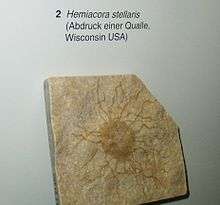Hiemalora
Hiemalora is a fossil of the Ediacaran biota, reaching around 3 cm in diameter, which superficially resembles a sea anemone. The genus has a sack-like body with faint radiating lines originally interpreted as tentacles, but discovery of a frond-like structure seemingly attached to some Heimalora has added weight to a competing interpretation: that it represents the holdfast of a larger organism.[2] This interpretation would stand against its original classification in the medusoid Cnidaria; it would also consign a once-popular hypothesis placing Hiemalora in the chondrophores,[3] on the basis of its tentacle structure, to the dustbin. Studies testing the feasibility of hypothesis investigated the possibilities that such fragile tentacles could be preserved, and concluded that it would be very improbable — especially as many Hiemalora bearing beds also contain such fossils as Cyclomedusa, but do not preserve the tentacles on these organisms.[4]
| Hiemalora | |
|---|---|
 | |
| H. stellaris | |
| Scientific classification | |
| Kingdom: | |
| Genus: | Hiemalora Fedonkin 1982 |
| Type species | |
| Hiemalora stellaris (Fedonkin, 1980) (=Pinegia stellaris Fedonkin, 1980) | |
| Species | |
| |
Heimalora has been identified in a wide range of facies and locations globally.[5]
Etymology
The genus was originally named Pinegia,[6] but was renamed two years later when it was realised that a genus of Permian insect already bore the name. [7][4] The revised name comes from Latin hiemalis ora, "winter coast".
See also
References
- Chen, Zhe; Zhou, Chuanming; Xiao, Shuhai; Wang, Wei; Guan, Chengguo; Hua, Hong; Yuan, Xunlai (2014). "New Ediacara fossils preserved in marine limestone and their ecological implications". Scientific Reports. 4: 4180. Bibcode:2014NatSR...4E4180C. doi:10.1038/srep04180. PMC 3933909. PMID 24566959.
- Hofmann, H.J. (2005). "HIEMALORA AND OTHER EDIACARAN FOSSILS OF NORTHEASTERN NEWFOUNDLAND, AND CORRELATIONS WITHIN AVALONIA". Geological Society of America Abstracts with Programs. 37 (7): 485. Archived from the original on 2008-10-10. Retrieved 2007-08-20.
- Seilacher, A.; Buatois, L.A.; Gabriela Mangano, M. (2005). "Trace fossils in the Ediacaran-Cambrian transition: Behavioral diversification, ecological turnover and environmental shift". Palaeogeography, Palaeoclimatology, Palaeoecology. 227 (4): 323–356. Bibcode:2005PPP...227..323S. doi:10.1016/j.palaeo.2005.06.003.
- Narbonne, G.M. (1994). "New Ediacaran Fossils from the Mackenzie Mountains, Northwestern Canada". Journal of Paleontology. 68 (3): 411–416. doi:10.1017/S0022336000025816. JSTOR 1306192.
- Waggoner, B. (1998). "The Ediacaran Biotas in Space and Time". Integrative and Comparative Biology. 43 (1): 104–113. doi:10.1093/icb/43.1.104. PMID 21680415.
- Fedonkin, M.A. (1980). "New representatives of the Precambrian coelenterates in the northern Russian platform". Paleontologicheskii Zhurnal (in Russian). 2: 7–15.
- Fedonkin, M.A. (1982). "New generic name for the Precambrian coelenterates". Paleontologicheskii Zhurnal (in Russian). 2: 137.